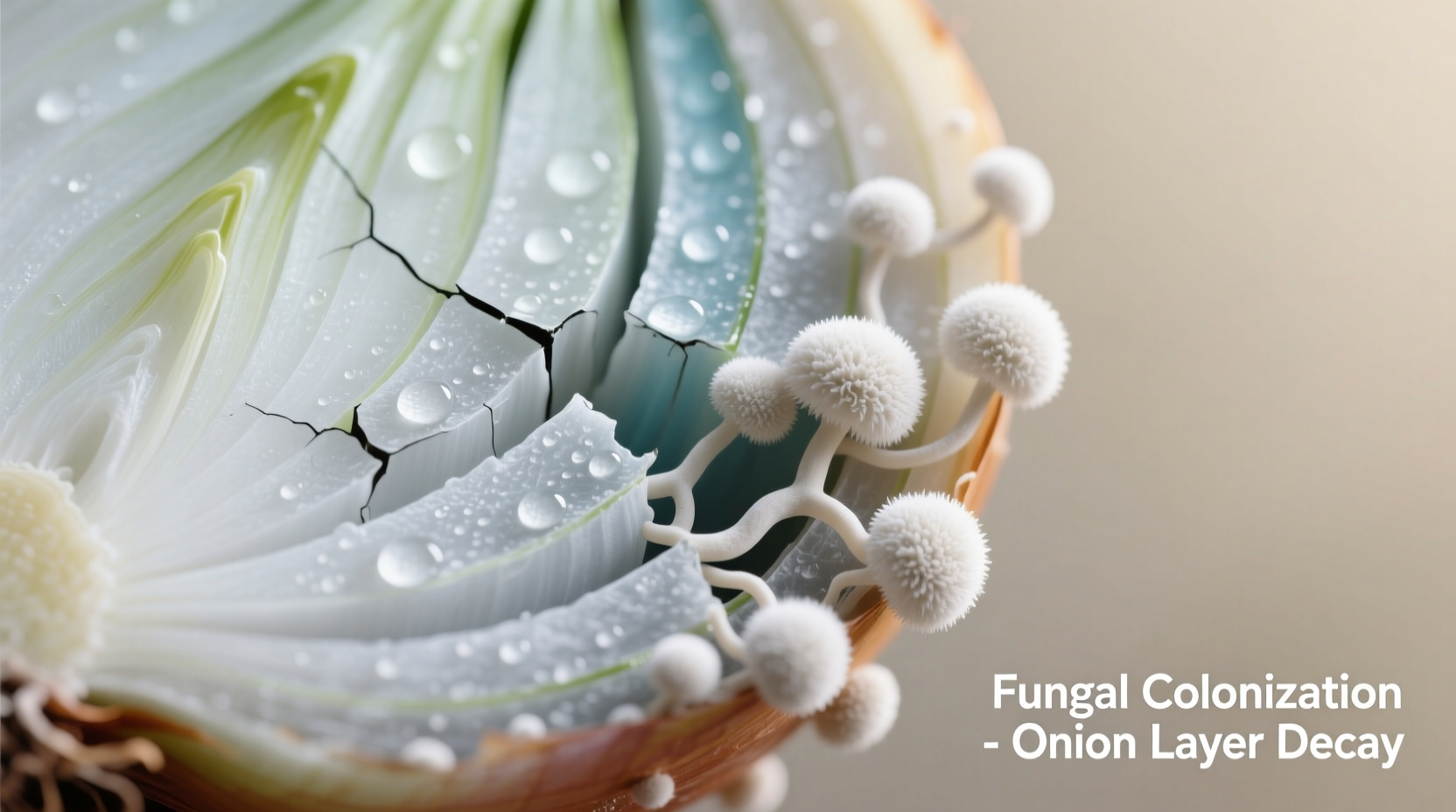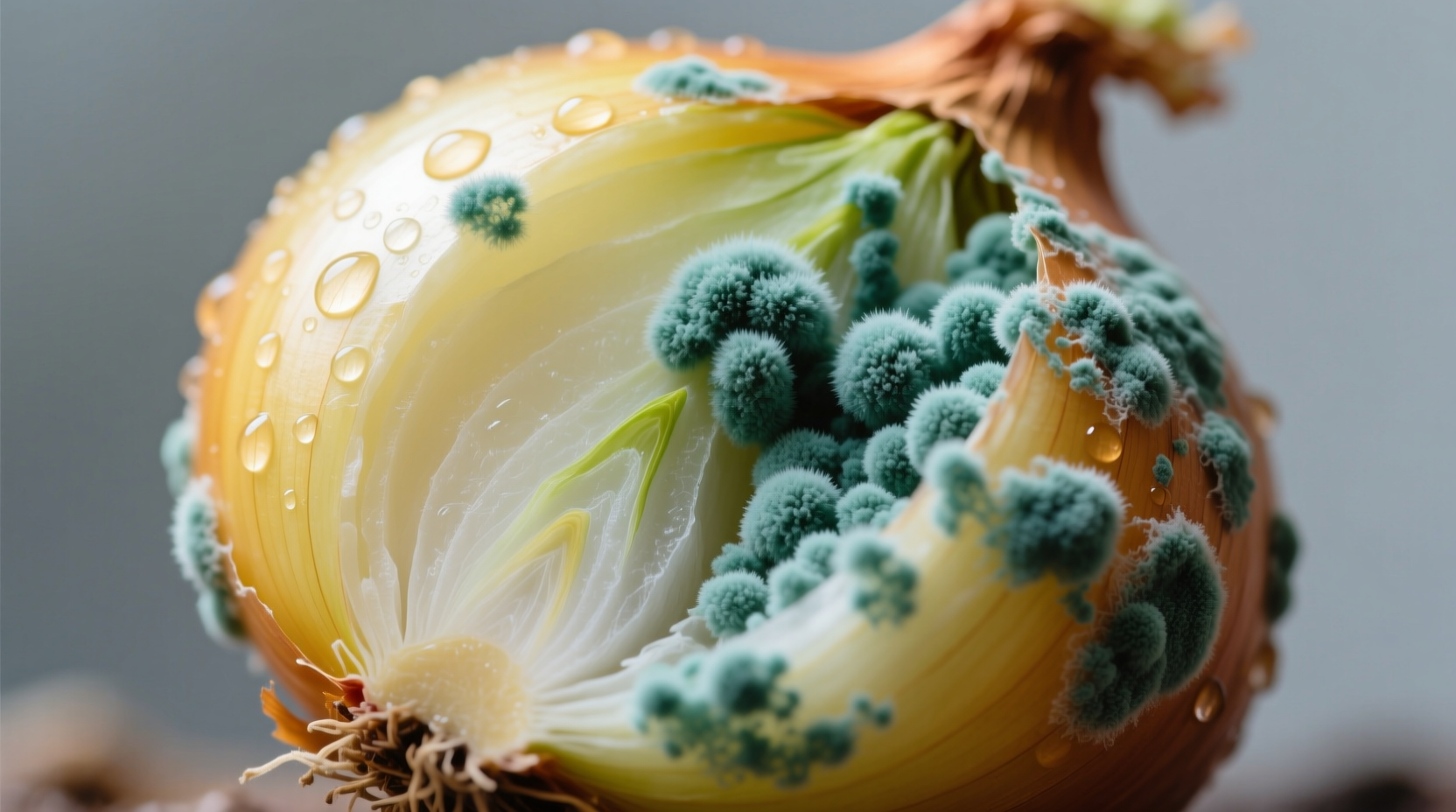Discovering mold on your onions can be frustrating, especially when you're ready to cook your favorite recipe. This comprehensive guide provides science-backed information about onion mold, helping you make safe decisions while reducing food waste. You'll learn how to properly identify dangerous mold, understand why cutting away the visible portion isn't safe, and implement effective storage techniques to prevent mold growth before it starts.
Understanding Mold Development on Onions
Onions develop mold when exposed to moisture and warm temperatures. Unlike harder produce like carrots or bell peppers, onions have a layered structure with high water content that allows mold filaments (hyphae) to penetrate throughout the entire bulb, even when visible mold appears only on the surface.
| Mold Development Stage | Visible Signs | Timeframe | Recommended Action |
|---|---|---|---|
| Initial Contamination | No visible signs | 0-3 days | Preventative measures critical |
| Early Growth | White fuzzy patches | 3-7 days | Discard immediately |
| Advanced Growth | Green, black, or blue spots | 7-14 days | Discard and clean storage area |
| Complete Infestation | Soft, slimy texture throughout | 2+ weeks | Discard and check nearby produce |
This timeline demonstrates why early detection matters. According to the USDA Food Safety and Inspection Service, soft fruits and vegetables with high moisture content like onions, tomatoes, and peaches should be completely discarded when mold is visible, as the roots can penetrate below the surface.
Why Cutting Away Mold Isn't Safe for Onions
Many home cooks wonder if they can simply cut off the moldy portion and use the rest of the onion. Unfortunately, this approach doesn't work for onions due to their structure and moisture content. The visible mold represents only a small portion of the fungal growth. Microscopic filaments extend throughout the onion, potentially carrying mycotoxins that aren't visible to the naked eye.
Unlike hard cheeses or firm vegetables like cabbage where mold penetration is limited, onions' layered structure creates pathways for mold to spread internally. The FDA explains that with high-moisture foods, "it's difficult to know how far the mold has spread and whether harmful bacteria may also be present."

Common Types of Onion Mold and Their Risks
Several types of mold commonly affect onions, each with different characteristics:
- Aspergillus niger - Appears as black spots, produces mycotoxins called ochratoxins which can affect kidney function
- Penicillium - Shows as blue-green fuzzy patches, some species produce mycotoxins
- Botrytis - Causes neck rot with grayish mold, particularly problematic in stored onions
While not all molds produce harmful substances, there's no reliable way for consumers to determine which molds are dangerous just by looking at them. The University of Minnesota Extension recommends treating all visible mold on high-moisture produce as potentially hazardous.
Practical Steps When You Find Moldy Onions
Discovering mold on your onions requires immediate action to prevent cross-contamination:
- Isolate the affected onion - Remove it from other produce without touching other items
- Inspect nearby produce - Check all onions and other vegetables stored nearby for signs of mold
- Proper disposal - Place the moldy onion in a sealed plastic bag before discarding to prevent spore spread
- Clean storage area - Wipe down shelves with a vinegar-water solution (1:1 ratio) or mild bleach solution
- Monitor other produce - Check remaining onions daily for the next week
Remember that mold spreads through airborne spores, so handling moldy produce carefully prevents contamination of your entire pantry. Never sniff moldy food directly, as this can cause respiratory issues.
Effective Prevention Strategies for Onion Storage
Preventing mold starts with proper selection and storage techniques. Follow these evidence-based methods to extend your onions' shelf life:
Selection Tips
Choose onions with dry, papery skins free from soft spots, blemishes, or signs of sprouting. Firmness indicates freshness - squeeze gently to check for soft areas that might indicate early decay.
Optimal Storage Conditions
Onions require specific conditions to prevent mold growth:
- Dry environment - Relative humidity below 70%
- Air circulation - Store in mesh bags or baskets, not plastic
- Temperature - Ideal range is 45-55°F (7-13°C)
- Darkness - Light promotes sprouting which leads to decay
- Separation - Store away from potatoes which emit moisture
The National Onion Association confirms that proper storage can extend onion shelf life to 2-3 months for yellow onions and up to 1 month for sweet varieties. Never store whole onions in the refrigerator, as the high humidity accelerates mold growth.
Special Considerations for Different Onion Types
Not all onions behave the same when it comes to mold susceptibility. Understanding these differences helps you manage your produce more effectively:
- Yellow onions - Most storage-friendly, can last 2-3 months when stored properly
- Red onions - Slightly more moisture, best used within 3-4 weeks
- White onions - Thinner skin makes them more prone to mold
- Sweet onions - Highest moisture content, most susceptible to mold (Vidalia, Walla Walla)
- Green onions - Should be used within 5-7 days, store with roots in water
When purchasing sweet onions, plan to use them first in your cooking rotation. Their higher sugar and water content makes them particularly vulnerable to mold development.
When Mold Might Not Be the Culprit
Not all discoloration on onions indicates mold. Sometimes what appears to be mold is actually:
- Sprouting - Green shoots emerging from the top (onion is still safe to eat)
- Neck rot - Darkening at the top where leaves were attached (trim affected area)
- Enzymatic browning - Brown spots after cutting (safe to eat, though quality declines)
True mold appears as fuzzy growth in white, green, black, or blue colors. If you're uncertain whether discoloration is mold or another condition, it's safest to discard the onion.
Food Safety Guidelines Across Different Contexts
Food safety recommendations for moldy onions vary slightly depending on your specific situation:
| Situation | Recommended Action | Reasoning |
|---|---|---|
| Single onion with small mold spot | Discard entire onion | Mold penetrates throughout high-moisture produce |
| Multiple onions showing mold | Discard all, clean storage area thoroughly | High risk of cross-contamination through airborne spores |
| Cut onion with mold | Discard entire container | Increased surface area accelerates mold growth and spread |
| Onion with sprouting but no mold | Use immediately, trim sprouts | Sprouting indicates aging but isn't hazardous |
These context-specific guidelines help you make appropriate decisions based on your particular circumstances while maintaining food safety standards.











 浙公网安备
33010002000092号
浙公网安备
33010002000092号 浙B2-20120091-4
浙B2-20120091-4